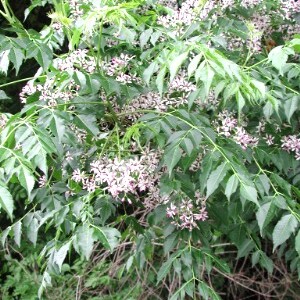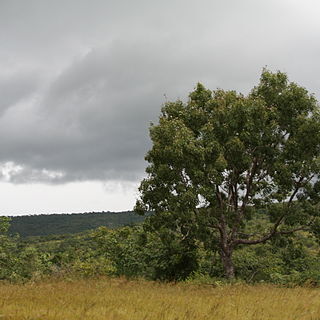Trees, shrubs, or sometimes shrublets, monopodial or sympodial, usually dioecious, less often monoecious or polygamo-dioecious. Stipules absent. Leaves in spirals, very rarely opposite, usually pinnate; leaflets opposite, subopposite, or alternate; leaflet blades with base somewhat oblique, margin usually entire or rarely lobed or serrate. Flowers usually in axillary thyrses, rarely racemose or spicate. Calyx small, 3-6-lobed or with distinct sepals, usually cup-shaped or tubular, imbricate or valvate in bud. Corolla contorted or imbricate, sometimes quincuncial. Petals (3 or)4 or 5(or 6), rarely more, distinct or connate, sometimes adnate to staminal tube and then valvate. Stamens 3-10 or more, hypogynous, mostly with a staminal tube (distinct stamens in Cedrela and Toona); anthers usually sessile on stamen tube, erect, included or exserted, 2-celled, longitudinally dehiscing. Disk tubular, annular, obsolete, or absent, free or adnate to ovary. Ovary usually free, 2-5(or more)-locular, with 1 to many collateral or superposed ovules per locule; style single or rarely absent; stigma disciform or capitate. Fruit a berry (dry but indehiscent with arillate seeds in some Aglaia sect. Aglaia), capsule, or rarely a drupe. Seeds winged or with a fleshy aril or sarcotesta wholly or partly covering seed; endosperm fleshy or usually absent.
Trees, treelets or rarely shrubs, dioecious, polygamous, monoecious or all flowers hermaphrodite. Indumentum of simple or stellate hairs, stellate or peltate scales, sometimes mixed. Vegetative buds naked or with scale-leaves (in Australia only in subfam. Cedreloideae). Leaves exstipulate, spirally arranged, rarely decussate, pinnate (sometimes with a terminal ‘bud’, i.e. pseudogemmula) to simple or bipinnate; leaflets usually entire. Inflorescences thyrsoid to spicate, fascicled or of simple flowers, axillary to cauliflorous or epiphyllous (not in Australia). Calyx of discrete sepals, sometimes transitional to bracteoles, or a tube, sometimes atop an elongate pseudopedicel. Petals usually in 1 whorl of 3–7. Stamens free or usually anthers borne on or in a tube; anthers usually 3–10 in 1 whorl. Disc (probably nectary) around ovary or absent. Ovary usually 2–6-locular, each locule with 1–many ovules. Fruit a capsule, berry or drupe. Seed with fleshy aril or sarcotesta or combination of these, or winged or corky or none of these; endosperm usually absent.
Ovary superior, (2) 4–5 (20)-locular, with axile placentation; ovules 1-? per loculus; style 1; style-head expanded, capitate, globose, ovoid, cylindric, discoid or coroniform, entire or shallowly lobed, only partly stigmatic, sometimes (Turraea) functioning as a receptaculum pollinis
Disk intrastaminal, very variable, often developed from the gynophore, completely fused to base of staminal tube, or annular, cup-shaped or cushion-shaped and free from staminal tube and ovary or cushion-shaped and enveloping the base of the ovary
Stamens (5) 8–10 (20), rarely completely free, usually partly or completely fused to form a staminal tube, usually bearing appendages; anthers 2-thecous, dehiscing longitudinally, connective usually apiculate beyond anther-lobes
Stamens mostly 8 or 10, rarely numerous, mostly with connate filaments, and the anthers often sessile in the tube; anthers 2-celled, opening lengthwise; disk various
Leaves usually alternate, 2-or 3-pinnate, simply impari-or pari-pinnate, 3-foliolate, 1-foliolate or simple; leaflets entire, crenate or serrate
Flowers bisexual or unisexual, monoecious or dioecious, occasionally polygamous, actinomorphic, mostly 5-merous; sepals and petals dissimilar
Sepals small, 4–6, variously connate or almost free, the lobes imbricate or with open aestivation, never completely covering corolla in bud
Inflorescence usually axillary or in axils of fallen leaves, of cymose panicles or compound or simple cymes or flowers fasciculate
Ovary superior, often 3–5-celled, stigma often disci-form or capitate; ovules mostly 2, rarely 1 or more
Petals free or partially connate, contorted or imbricate, or adnate to the staminal tube and valvate
Seeds usually arillate, winged or with a corky outer integument; endosperm present or absent
Fruit baccate, capsular or rarely a drupe, often with a large central axis
Trees or shrubs, mostly with hard scented wood, very rarely subherbaceous
Petals usually 4–5, free, valvate, imbricate or contorted
Fruit a loculicidal or septifragal capsule or a drupe
Leaves alternate, mostly pinnate; stipules absent
Indumentum of simple, glandular or stellate hairs
Seeds with or without endosperm, sometimes winged
Calyx often small, imbricate, rarely valvate
Flowers actinomorphic, mostly hermaphrodite
Trees, shrubs or shrublets
Wood often scented
Stipules absent


